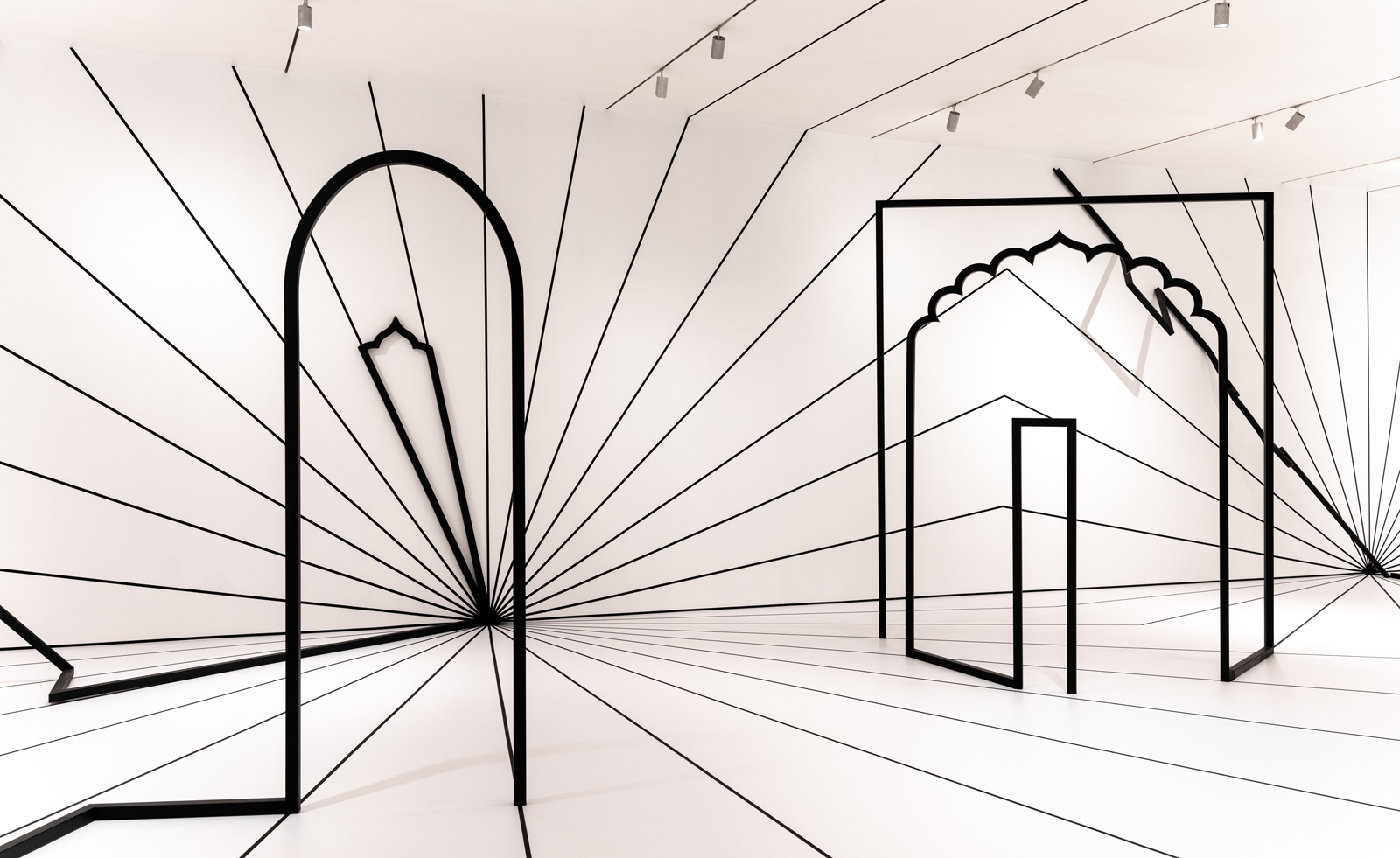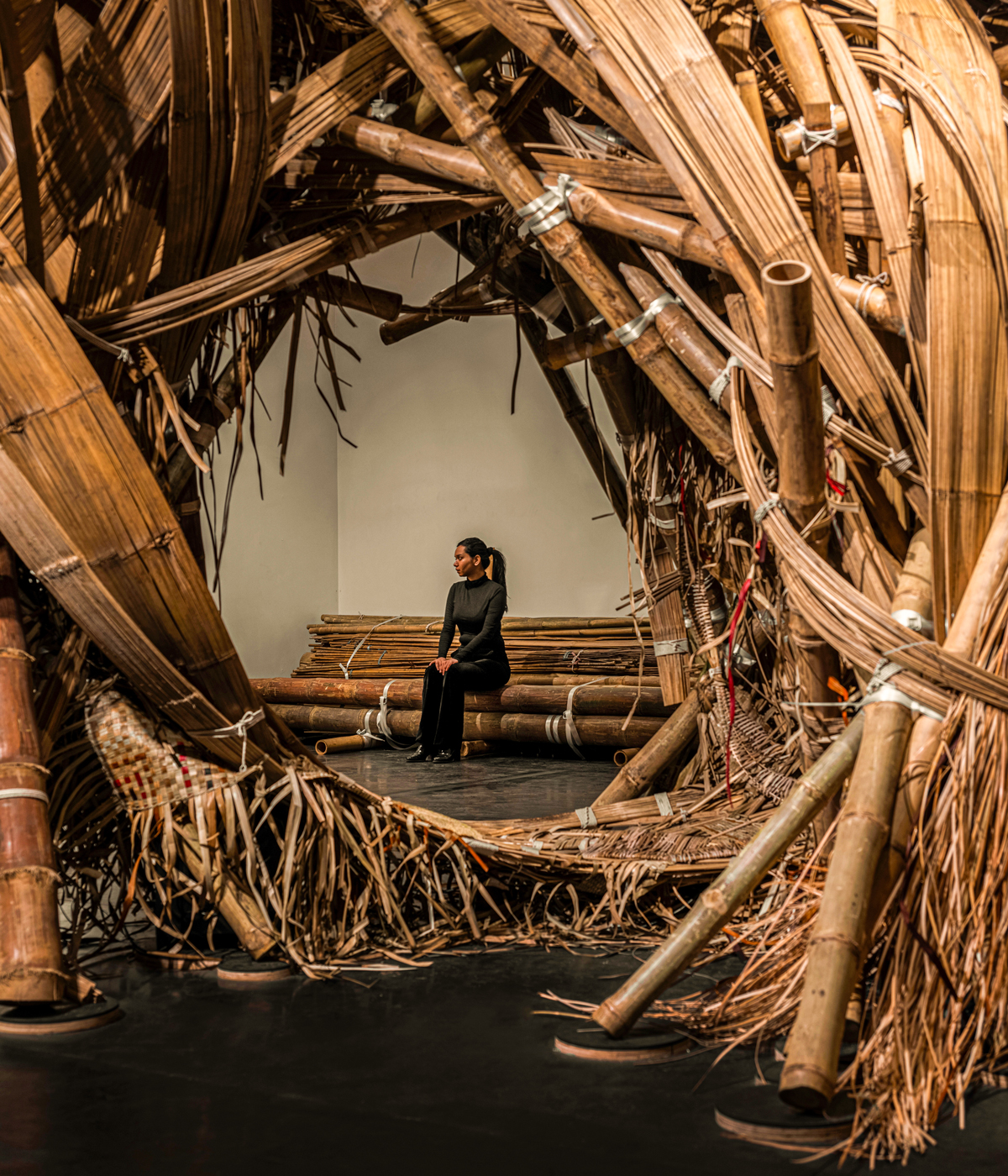
To be in your youth is to be fresh, cool, contemporary, courageous, and conspicuous, at the precipice of something. ‘Liminal Gaps’ at the NMACC in Mumbai is a youthful show. It awakens a quality of restless potential from one floor to another, embodying a different artist’s idea of liminality as they invite you to join them at their threshold, and in that, discover your own. Curated by the dynamic creative house, Triadic, in its signature expansive approach, the show makes something incredible of space at NMACC’s Art House, while taking it up with a thoughtful impunity.
As Roya Sachs, creative director of Triadic, says, ‘We are always inspired by the idea of how we can bridge disciplines – performance, sculpture, digital, multimedia – and take risks. That is where the magic happens‘.
‘Liminal Gaps’ at NMACC, Mumbai

Raqs Media Collective and Frith Street Gallery, “Escapement.” Courtesy of Art House, NMACC
Intentionally breaking from the sterile, white gallery box that defines and often confines, Triadic is all about the temporal and the tangible. ‘We want people to occupy art, find joy and delight, and leave feeling something,‘ add Elizabeth Edelman Sachs, producer at Triadic. This is very evident right from the time one begins traversing the show – with Ayesha Singh’s Hybrid Drawings. A white room is cut by black lines, converging at ‘vanishing points’ typical of a two-point-perspective drawing. The lines form arches, windows, frames, openings, pathways, divisions, directions, taking from the geometry of Islamic, Hindu, Sikh, and Victorian architecture of Delhi, where Ayesha grew up.

Asim Waqif, “Chaal”, 2024. Courtesy of Art House, NMACC
The Raqs Media Collective (established in 1992) presents five works that are meditations on time. The underbelly connecting each floor is enveloped by a mural: a cobalt blue background with and expressions like ‘hit a raw nerve’, ‘nerves of steel’, ‘you have some nerve’ alongside drawings of neurons (nerve cells). One is welcomed on the next floor with Chromacron, where stripes of Pantone colours of the years 2000-2024 line up in chronological order, leading to the installation entitled Escapement. A collection of 27 seemingly identical clocks are marked with moods and emotions – remorse, awe, fear, epiphany – instead of numbers/hours. Another giant clock’s digits are replaced by words in the Devanagari script (used to write Sanskrit, Prākrit, Hindi, Marathi, and Nepali) that take on literal and symbolic meanings; shran (second), pran (life), atithi (guest), ritu (season), to name a few. At the ‘blank’ centre of the space sits ‘Betaal’, an augmented reality that can be seen using iPads, perceived by Raqs as an entity that moves in the liminal gap between time and consciousness.
On the third floor, Asim Waqif’s Chaal takes on an ecological and anthropological approach to liminality. Thirty skilled artisan-craftsman-labourers collaborated to make a structure in bamboo with little to no prescription in terms of drawings, sketches and models. The lights, sounds, coves, and experiential nooks enmeshed in the structure invite the viewer to inhabit and find the many meanings of the word chaal: tempo, impulse, trick/move and gait/movement.
At the topmost floor is the final chapter, a fantastical multimedia story that serves as a world-building interactive experience. Afra Shafiq’s Sultana’s Reality (2017) draws from Begum Rokheya Sakhawat Hossain’s feminist utopia entitled Sultana’s Dream (1905) a story of the reversed ‘purdah’ – the seclusion of women – in a world run by women. You are led into a literal black box, lit by neon green grid lines, a few seats facing an LCD screen. This digital liminal space comes to life in a computer game depicting lives of women at different time periods in the subcontinent. The multimedia story traces women and colonial education movement in India using archival imagery, humour, contemporary culture, and historical nuggets. Time has no purpose in Sultana’s Reality.
‘We were very intentional in picking a combination of established and emerging Indian artists, giving both the same expanse of space. This allows us to embrace play and encourage spontaneity with the art and the audience, a tenet crucial to our work.’
Receive our daily digest of inspiration, escapism and design stories from around the world direct to your inbox.
‘Liminal Gaps’ is on now at NMACC, Mumbai, until 9 June 2024, nmacc.com
Aastha D. (she/they) is an independent scholar, essayist, and educator. They have degrees in architecture and its critical, curatorial, and conceptual practices. She founded the magazine Proseterity, and is also managing editor of the working group Insurgent Domesticities at the Center for the Study of Social Difference (CSSD) of Columbia University
-
 Usher opens up about breakfast playlists, banana pudding and why a glass tumbler is always on his rider
Usher opens up about breakfast playlists, banana pudding and why a glass tumbler is always on his riderOn the heels of a collaboration with Baccarat, the Grammy-winning singer-songwriter breaks down his entertaining tips. 'Hosting is an expression of how you feel about your guests and also who you are.'
-
 The beauty trends that will define 2026, from ultra-niche fragrances to anti-ageing dental care
The beauty trends that will define 2026, from ultra-niche fragrances to anti-ageing dental careAs we enter the new year, we speak to experts in fragrance, skincare, aesthetics, wellness and more about the trends that will be shaping the way we look
-
 The most stylish hotel debuts of 2025
The most stylish hotel debuts of 2025A Wallpaper* edit of this year’s defining hotel openings. Design-led stays to shape your next escape
-
 Toiletpaper’s surreal world goes on view in Mumbai
Toiletpaper’s surreal world goes on view in MumbaiToiletpaper artists Maurizio Cattelan and Pierpaolo Ferrari present ‘Run As Slow As You Can’ at the NMACC (until 22 October 2023), a sensory overload infused with Indian flavour
-
 Is NMACC Mumbai’s new crown jewel of culture?
Is NMACC Mumbai’s new crown jewel of culture?The newly inaugurated Nita Mukesh Ambani Cultural Centre (NMACC) in Mumbai is a spectacular first-of-its-kind art space for India. We explore the centre, and its art-, fashion-, and design-filled offerings